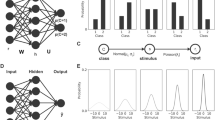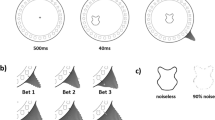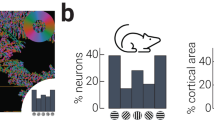Abstract
Humans are good at performing visual tasks, but experimental measurements have revealed substantial biases in the perception of basic visual attributes. An appealing hypothesis is that these biases arise through a process of statistical inference, in which information from noisy measurements is fused with a probabilistic model of the environment. However, such inference is optimal only if the observer's internal model matches the environment. We found this to be the case. We measured performance in an orientation-estimation task and found that orientation judgments were more accurate at cardinal (horizontal and vertical) orientations. Judgments made under conditions of uncertainty were strongly biased toward cardinal orientations. We estimated observers' internal models for orientation and found that they matched the local orientation distribution measured in photographs. In addition, we determined how a neural population could embed probabilistic information responsible for such biases.
This is a preview of subscription content, access via your institution
Access options
Subscribe to this journal
Receive 12 print issues and online access
$209.00 per year
only $17.42 per issue
Buy this article
- Purchase on Springer Link
- Instant access to full article PDF
Prices may be subject to local taxes which are calculated during checkout








Similar content being viewed by others
References
Helmholtz, H. Treatise on Physiological Optics (Thoemmes Press, Bristol, UK, 2000).
El-Bizri, N. A philosophical perspective on Alhazen's optics. Arab. Sci. Philos. 15, 189–218 (2005).
Knill, D.C. & Richards, W. Perception as Bayesian Inference (Cambridge University Press, Cambridge, UK, 1996).
Geisler, W.S., Perry, J.S., Super, B.J. & Gallogly, D.P. Edge co-occurrence in natural images predicts contour grouping performance. Vision Res. 41, 711–724 (2001).
Simoncelli, E.P. Distributed Analysis and Representation of Visual Motion. PhD thesis, Massachusetts Institute of Technology (1993).
Griffiths, T.L., Kemp, C. & Tenenbaum, J.B. Bayesian models of cognition. in Cambridge Handbook of Computational Psychology (ed. Sun, R.) 59–100 (Cambridge University Press, 2008).
Körding, K.P. & Wolpert, D.M. Bayesian integration in sensorimotor learning. Nature 427, 244–247 (2004).
Tassinari, H., Hudson, T.E. & Landy, M.S. Combining priors and noisy visual cues in a rapid pointing task. J. Neurosci. 26, 10154–10163 (2006).
Mamassian, P. & Goutcher, R. Prior knowledge on the illumination position. Cognition 81, 1–9 (2001).
Burge, J., Fowlkes, C.C. & Banks, M.S. Natural-scene statistics predict how the figure-ground cue of convexity affects human depth perception. J. Neurosci. 30, 7269–7280 (2010).
Weiss, Y., Simoncelli, E.P. & Adelson, E.H. Motion illusions as optimal percepts. Nat. Neurosci. 5, 598–604 (2002).
Brainard, D.H. et al. Bayesian model of human color constancy. J. Vis. 6, 1267–1281 (2006).
Stocker, A.A. & Simoncelli, E.P. Noise characteristics and prior expectations in human visual speed perception. Nat. Neurosci. 9, 578–585 (2006).
Dakin, S.C. Information limit on the spatial integration of local orientation signals. J. Opt. Soc. Am. A Opt. Image Sci. Vis. 18, 1016–1026 (2001).
Appelle, S. Perception and discrimination as a function of stimulus orientation: the “oblique effect” in man and animals. Psychol. Bull. 78, 266–278 (1972).
Landy, M.S., Goutcher, R., Trommershäuser, J. & Mamassian, P. Visual estimation under risk. J. Vis. 7, 1–15 (2007).
Coppola, D.M., Purves, H.R., McCoy, A.N. & Purves, D. The distribution of oriented contours in the real world. Proc. Natl. Acad. Sci. USA 95, 4002–4006 (1998).
van der Schaaf, A. & van Hateren, J.H. Modelling the power spectra of natural images: statistics and information. Vision Res. 36, 2759–2770 (1996).
Switkes, E., Mayer, M.J. & Sloan, J.A. Spatial frequency analysis of the visual environment: anisotropy and the carpentered environment hypothesis. Vision Res. 18, 1393–1399 (1978).
Farid, H. & Simoncelli, E.P. Differentiation of discrete multidimensional signals. IEEE Trans. Image Process. 13, 496–508 (2004).
Campbell, F.W. & Robson, J.G. Application of Fourier analysis to the visibility of gratings. J. Physiol. (Lond.) 197, 551–566 (1968).
Tomassini, A., Morgan, M.J. & Solomon, J.A. Orientation uncertainty reduces perceived obliquity. Vision Res. 50, 541–547 (2010).
Schwartz, O., Hsu, A. & Dayan, P. Space and time in visual context. Nat. Rev. Neurosci. 8, 522–535 (2007).
Shadlen, M.N., Britten, K.H., Newsome, W.T. & Movshon, J.A. A computational analysis of the relationship between neuronal and behavioral responses to visual motion. J. Neurosci. 16, 1486–1510 (1996).
Cohen, E.H. & Zaidi, Q. Fundamental failures of shape constancy resulting from cortical anisotropy. J. Neurosci. 27, 12540–12545 (2007).
Maloney, L.T. & Mamassian, P. Bayesian decision theory as a model of human visual perception: testing Bayesian transfer. Vis. Neurosci. 26, 147–155 (2009).
Birch, E.E., Gwiazda, J., Bauer, J.A. Jr. Naegele, J. & Held, R. Visual acuity and its meridional variations in children aged 7–60 months. Vision Res. 23, 1019–1024 (1983).
Timney, B.N. & Muir, D. Orientation anisotropy: incidence and magnitude in Caucasian and Chinese subjects. Science 193, 699–701 (1976).
Mayer, M.J. Development of anisotropy in late childhood. Vision Res. 17, 703–710 (1977).
Blakemore, C. & Cooper, G.F. Development of the brain depends on the visual environment. Nature 228, 477–478 (1970).
Mitchell, D.E., Freeman, R.D., Millodot, M. & Haegerstrom, G. Meridional amblyopia: evidence for modification of the human visual system by early visual experience. Vision Res. 13, 535–558 (1973).
Orban, G.A., Vandenbussche, E. & Vogels, R. Human orientation discrimination tested with long stimuli. Vision Res. 24, 121–128 (1984).
Li, B., Peterson, M.R. & Freeman, R.D. The oblique effect: a neural basis in the visual cortex. J. Neurophysiol. 90, 204–217 (2003).
De Valois, R.L., Yund, E.W. & Hepler, N. The orientation and direction selectivity of cells in macaque visual cortex. Vision Res. 22, 531–544 (1982).
Chapman, B. & Bonhoeffer, T. Overrepresentation of horizontal and vertical orientation preferences in developing ferret area 17. Proc. Natl. Acad. Sci. USA 95, 2609–2614 (1998).
Furmanski, C.S. & Engel, S.A. An oblique effect in human primary visual cortex. Nat. Neurosci. 3, 535–536 (2000).
Jazayeri, M. & Movshon, J.A. Optimal representation of sensory information by neural populations. Nat. Neurosci. 9, 690–696 (2006).
Zhang, K., Ginzburg, I., McNaughton, B.L. & Sejnowski, T.J. Interpreting neuronal population activity by reconstruction: unified framework with application to hippocampal place cells. J. Neurophysiol. 79, 1017–1044 (1998).
Simoncelli, E.P. Optimal estimation in sensory systems. in The Cognitive Neurosciences IV (ed. Gazzaniga, M.) 525–535 (MIT Press, 2009).
Fischer, B.J. Bayesian estimates from heterogeneous population codes. Int. Jt. Conf. Neural Netw. 1–7 (2010).
Ringach, D.L., Shapley, R.M. & Hawken, M.J. Orientation selectivity in macaque V1: diversity and laminar dependence. J. Neurosci. 22, 5639–5651 (2002).
Georgopoulos, A.P., Schwartz, A.B. & Kettner, R.E. Neuronal population coding of movement direction. Science 233, 1416–1419 (1986).
Ma, W.J., Beck, J.M., Latham, P.E. & Pouget, A. Bayesian inference with probabilistic population codes. Nat. Neurosci. 9, 1432–1438 (2006).
Seung, H.S. & Sompolinsky, H. Simple models for reading neuronal population codes. Proc. Natl. Acad. Sci. USA 90, 10749–10753 (1993).
Ganguli, D. & Simoncelli, E.P. Implicit encoding of prior probabilities in optimal neural populations. in Advances in Neural Information Processing Systems 23 NIPS. (eds. Williams, C., Lafferty, J., Zemel, R., Shawe-Taylor, J. & Culotta, A). (MIT Press, Cambridge, Massachusetts, 2010).
Green, D.M. & Swets, J.A. Signal Detection Theory and Psychophysics (Wiley, Oxford, UK, 1966).
Stocker, A.A. & Simoncelli, E.P. Visual motion aftereffects arise from a cascade of two isomorphic adaptation mechanisms. J. Vis. 9, 1–14 (2009).
Burt, P. & Adelson, E. The Laplacian pyramid as a compact image code. IEEE Trans. Commun. 31, 532–540 (1983).
Granlund, G.H. & Knutsson, H. Signal Processing for Computer Vision (Kluwer Academic Publishers, Norwell, Massachusetts, 1995).
Swindale, N.V. Orientation tuning curves: empirical description and estimation of parameters. Biol. Cybern. 78, 45–56 (1998).
Acknowledgements
We wish to thank D. Ganguli for helpful discussions on image statistics and population coding, T. Saarela for the monitor calibration and N. Solomon for assisting with the experiments. This work was funded by US National Institutes of Health grants EY019451 (A.R.G.) and EY16165 (M.S.L.), and the Howard Hughes Medical Institute (E.P.S.).
Author information
Authors and Affiliations
Contributions
A.R.G., M.S.L. and E.P.S. contributed to the design of the experiments, design of the analyses and the writing of the manuscript. A.R.G. conducted the experiments and performed the analyses.
Corresponding author
Ethics declarations
Competing interests
The authors declare no competing financial interests.
Supplementary information
Supplementary Text and Figures
Supplementary Figures 1–5 (PDF 504 kb)
Rights and permissions
About this article
Cite this article
Girshick, A., Landy, M. & Simoncelli, E. Cardinal rules: visual orientation perception reflects knowledge of environmental statistics. Nat Neurosci 14, 926–932 (2011). https://doi.org/10.1038/nn.2831
Received:
Accepted:
Published:
Issue Date:
DOI: https://doi.org/10.1038/nn.2831
This article is cited by
-
A unifying theory explains seemingly contradictory biases in perceptual estimation
Nature Neuroscience (2024)
-
Sensory perception relies on fitness-maximizing codes
Nature Human Behaviour (2023)
-
Neural tuning instantiates prior expectations in the human visual system
Nature Communications (2023)
-
Motion direction is represented as a bimodal probability distribution in the human visual cortex
Nature Communications (2023)
-
Working memory performance is tied to stimulus complexity
Communications Biology (2023)



